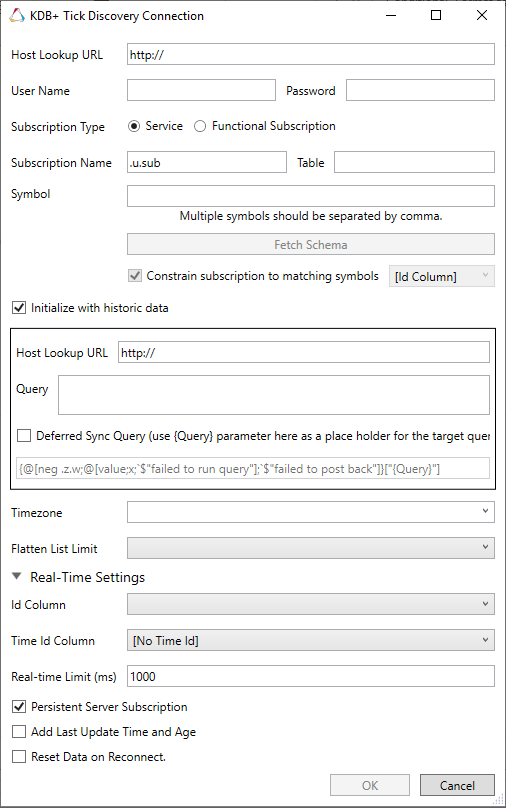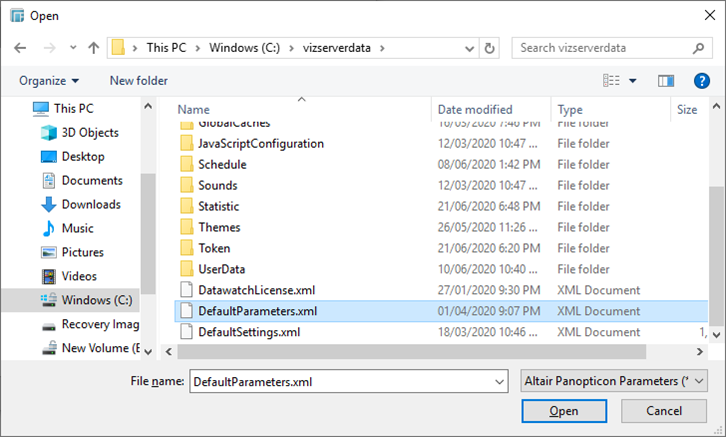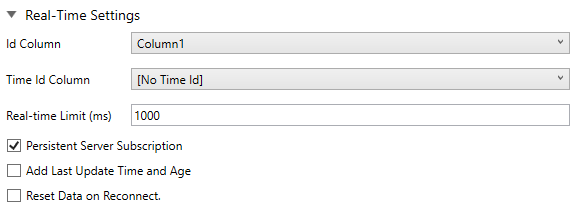Kx kdb+tick Discovery
The Kx kdb+tick Discovery connector is very similar to the Kx kdb+tick connector, except that the former is using a Host Lookup URL for the host information (i.e., Host, Port, User Name, and Password).
Using Kx kdb+tick Discovery
-
When creating a new data table, select KDB + Tick Discovery from the Connect to Data dialog. The KDB + Tick Discovery Connection dialog is displayed:

-
Enter the Host Lookup URL.
-
Enter or set the following:
-
-
Service
-
Enter the following properties:
-
Subscription service (e.g., sub)
-
Tab to subscribe against (e.g., trade)
-
Symbol to subscribe against (e.g., AAPL)
NOTE: Multiple symbols should be separated by a comma.
-
-
Functional Subscription
-
Enter the functional subscription that needs to be issued (e.g., u.sub['trade;']
-
Click Fetch Schema to retrieve the schema of the configured subscription.

This populates the Id Column with the set of columns from the schema of type sym and the text array such as Character/Boolean/GUID, etc.
-
Check Constrain subscription to matching symbols to select the column which contains specific symbols. Otherwise, the filtering against these symbols will not take place.
NOTE: The Constrain subscription to matching symbols only lists sym fields. Therefore, if you select a non sym type in the Id Column, it is not recommended to select the default value [Id Column] in the Constrain subscription to matching symbols drop-down list.
-
Activate or deactivate Initialize with historic data. If unchecked, the data source will only be populated with streaming updates that are subscribed against. If checked, the data source is first initialized against a store of data, after which subscribed streaming updates are then applied.
As a result, when this option is unchecked, viewing the visualization on the Panopticon Visualization Server, the initial graph will be empty, as it is being built up as data arrives. If checked, the initial graph can be populated with historical data, and then start scrolling as new data updates occur.
-
Enter the following information:
-
-
Host
-
Port
-
User Name
-
Password
-
Query
-
All these values can be parameterized.
-
Select the Time zone.
-
Select the Flatten List Limit.
This allows retrieval of the first ‘n’ items in the list and produce new columns in the output schema with a dot notation.
For example, if there are two nested fields (BidPrices and OfferPrices) and the flatten list limit selected is five, then the output schema will be:
BidPrices.1, BidPrices.2, BidPrices.3, BidPrices.4, BidPrices.5, OfferPrices.1, OfferPrices.2, OfferPrices.3, OfferPrices.4, OfferPrices.5
If there are less than five items in the list, then the values will be null.
NOTE: Currently, this feature works for the Service subscription type. Also, it only flattens numeric columns.
-
Expand Real-Time Settings.

Refer to Defining Real-Time Settings for more information.
-
Click OK to confirm the selection and retrieve the record set into Panopticon Designer (Desktop).
Initially, there is no data displayed in the Data Source Preview section of the Edit Data Table window.
Click the Start Preview button to display the data and refresh the values depending on the defined Refresh Period.



